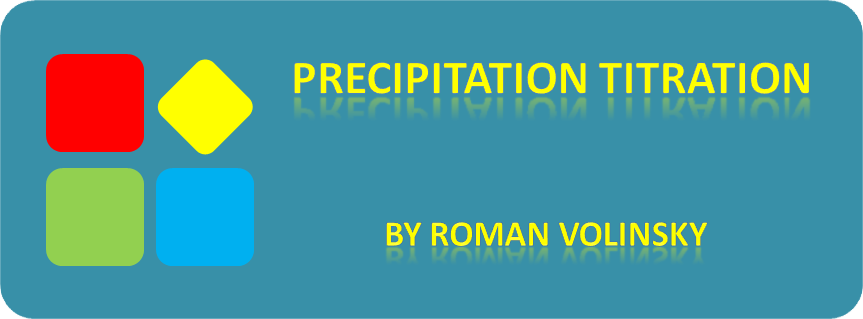Precipitation titration is a type of chemical titrimetric analysis, where precipitation reaction between the analyte and titrant serves as titration method. Visually titration can be followed, by means of color changing indicators, that form precipitate (Mohr method), or complex (Volhard method) with excess of titrant or adsorb to the titration precipitate (Fajans method) . In this post we will provide detailed quantitative analysis and build a curve of a precipitation titration with a help of “Chemical Solution Wizard” and “Solubility “ applications.
Let’s start from simple titration of of 100.0 mL of 0.0500 M NaCl with 0.100 M AgNO3. The precipitation reaction standing behind the titration is:
Ag+(aq)+Cl−(aq) ⇌ AgCl(s)
As a rule of thumb, the titration reaction must proceede to completion, which is the case, when equilibrium constant is large:
K = (Ksp)−1 = (1.77×10−10)−1 = 5.65×109 M-2
We will add in a stepwise manner, 10 ml aliquotes of AgNO3 solution, while each time calculating:
1. The initial (before reaction) concentrations of the analyte (Cl−) and titrant (Ag+),by means of “Chemical Solution Wizard” application.
2. The post-reaction, equilibrium concentrations of the analyte (Cl−) and titrant (Ag+), by means of “Solubility” application.
Finally, we will plot the titration curve, that will represent the functional relationship between p-values (– log) of an analyte (Cl−) or titrant (Ag+) concentration and volume of a titrant solution.
As an example lets present a calculation for a first titration point, achieved after addition of 10 ml of AgNO3:
Typing concentrations and volumes of the solutions to the “Mixture” section of the “Chemical Solution Wizard” app, provides us with final concentrations of the reagents before any reactions:

So at a first step (10ml), [NaCl] = 45.45mM and [AgNO3] = 9.091mM, when total volume is 110 ml.
Importantly, to get these values for all other points, we simply have to change the AgNO3 volume (20ml, 30ml, etc. ) and to press enter!
The reaction and Ksp info of AgCl can be derived directly from the “Solubility” database:

Next step is setting the final volume and pre reaction concentrations:

Quotient of the reaction exceeds the Ksp value, suggesting that the precipitation reaction will proceed. Equilibrium concentrations are [Ag+]eq = 4.868 nM and [Cl−]eq = 36.36 mM.
Exactly the same steps must be repeated for every new addition of AgNO3.
The final titration table:
| Volume AgNO3, ml | [Cl−]eq | [Ag+]eq | pCl− | pAg+ |
| 0 | 0.05 M | 0.1 M | 1.30 | – |
| 10 | 36.4 mM | 4.87 nM | 1.44 | 8.31 |
| 20 | 25 mM | 7.08 nM | 1.60 | 8.15 |
| 30 | 15.4 mM | 11.5 nM | 1.81 | 7.94 |
| 40 | 7.14 mM | 24.7 nM | 2.15 | 7.61 |
| 49 | 670 µM | 264 nM | 3.17 | 6.58 |
| 50 | 13.3 µM | 13.3 µM | 4.88 | 4.88 |
| 51 | 268 nM | 660 µM | 6.58 | 3.18 |
| 60 | 28.3 nM | 6.25 mM | 7.55 | 2.20 |
| 70 | 15.0 nM | 11.8 mM | 7.82 | 1.93 |
| 80 | 10.6 nM | 16.7 mM | 7.97 | 1.78 |
| 90 | 8.41 nM | 21.1 mM | 8.08 | 1.68 |
| 100 | 7.08 nM | 25 mM | 8.14 | 1.60 |
And here is the tiration plot, showing abrupt changes in concentrations of Ag+ and Cl−, at close vicinity of the equivalence point, that is achieved after addition of 50 ml of titrant.




One thought on “Precipitation Titration”
Comments are closed.